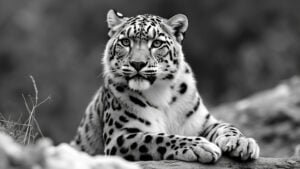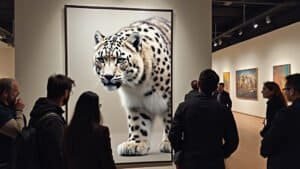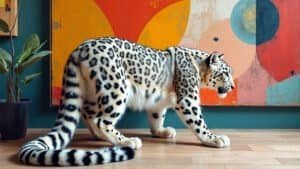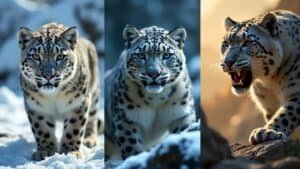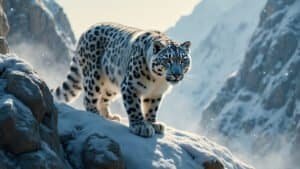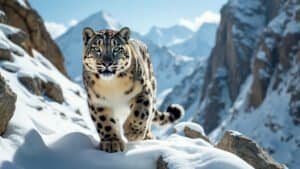Introduction
Snow leopards have long been a source of inspiration in the traditional art forms of various cultures across Central Asia and the Himalayas. Their majestic presence is not only a reflection of their ecological importance but also of their deep symbolic significance in the spiritual and cultural practices of these regions
This article explores how snow leopards are depicted in traditional art forms such as Tibetan thangka paintings, Mongolian carvings, and Kazakh textiles. By examining the artistic techniques, symbolism, and cultural meanings associated with these depictions, we gain insight into the unique ways that different cultures revere and represent these elusive big cats
Snow Leopards in Tibetan Thangka Paintings
Tibetan thangka paintings are intricate works of art that hold deep spiritual significance within Tibetan Buddhism. These scroll paintings, often used as aids in meditation and religious ceremonies, depict various deities, mandalas, and scenes from Buddhist cosmology
Among the many elements that may be featured in a thangka, the snow leopard stands out as a powerful symbol of strength, fearlessness, and the connection between the spiritual and natural worlds
The portrayal of snow leopards in thangka art not only reflects their revered status in Tibetan culture but also serves as a visual representation of important Buddhist teachings
Historical Context and Symbolism
The snow leopard’s presence in Tibetan thangka paintings can be traced back to the animal’s symbolic role in the region’s religious and cultural history
In Tibetan Buddhism, snow leopards are often associated with the protector deities, particularly those linked to the rugged mountain landscapes where these animals are found. The snow leopard embodies qualities such as agility, resilience, and a fierce, yet graceful, power—traits that are admired and revered in the context of spiritual practice
In thangka paintings, snow leopards are sometimes depicted as the companions or mounts of deities, emphasizing their role as guardians of sacred spaces
These depictions symbolize the snow leopard’s ability to navigate both the physical and spiritual realms, serving as a guide for practitioners seeking to overcome obstacles on their spiritual journey. The snow leopard’s white, spotted coat is also seen as a symbol of purity and the clarity of mind that is essential for enlightenment
In addition to their religious symbolism, snow leopards in Tibetan art represent the harmonious relationship between humans and nature
The animals are revered not only for their physical beauty and strength but also for their role in the ecosystem, where they are seen as guardians of the high mountains. This reverence is reflected in the careful and respectful way they are depicted in thangka paintings, where every detail is imbued with symbolic meaning
Artistic Techniques and Materials
Creating a thangka painting is a meticulous and time-consuming process that requires a high level of skill and dedication
The artists, known as thangka painters or “lhapchen,” undergo years of training to master the techniques and to understand the religious significance of the images they create. The depiction of snow leopards in thangkas involves a careful balance of realism and symbolism, with each element of the animal’s form and surroundings chosen to convey deeper spiritual meanings
The snow leopard is typically portrayed in a dynamic pose, reflecting its agility and power. Its muscular body and fluid movements are rendered with precision, capturing the essence of the animal’s grace and strength
The use of fine, delicate brushstrokes allows the artist to depict the intricate details of the snow leopard’s fur, emphasizing the contrast between its white coat and the dark rosettes that adorn it. This attention to detail is not only a testament to the artist’s skill but also a reflection of the reverence with which the snow leopard is regarded
The materials used in thangka painting are also significant. Traditionally, thangkas are painted on cotton or silk cloth, using natural pigments derived from minerals, plants, and precious stones
These pigments are carefully prepared to create vibrant, long-lasting colors that are symbolic in themselves. For instance, the white of the snow leopard’s fur might be created using ground chalk or gypsum, symbolizing purity and spiritual clarity, while the dark spots could be rendered with charcoal or ink, representing the balance of light and darkness
The background of a thangka featuring a snow leopard often includes elements of the high-altitude landscapes where these animals live, such as jagged mountain peaks, swirling clouds, and sacred lakes
These elements are not merely decorative; they are integral to the spiritual narrative of the painting, representing the challenges and obstacles that practitioners must overcome on their path to enlightenment
Influence on Buddhist Art
The depiction of snow leopards in Tibetan thangka paintings has influenced Buddhist art beyond the borders of Tibet, spreading to other Himalayan regions such as Bhutan, Nepal, and India
In these areas, snow leopards are similarly revered, and their representations in art continue to carry the same symbolic meanings associated with protection, strength, and spiritual purity
In Bhutanese thangka art, for example, snow leopards are often included in depictions of local deities and spirits associated with the mountains. These paintings, like their Tibetan counterparts, emphasize the snow leopard’s role as a guardian and guide, helping practitioners navigate the spiritual challenges they face
The techniques and styles used to depict snow leopards in Bhutanese thangkas are closely related to those of Tibetan art, but they also incorporate local artistic traditions and symbolism
Similarly, in Nepal, the snow leopard appears in the thangka paintings of the Sherpa people, who live in the shadow of the Himalayas. For the Sherpas, snow leopards are seen as protectors of the mountains, and their depictions in art serve as reminders of the sacredness of the natural world
These paintings often feature snow leopards in the context of mandalas or other spiritual symbols, highlighting their importance in the cosmological and spiritual beliefs of the region
The influence of snow leopard depictions in thangka paintings can also be seen in modern Buddhist art, where contemporary artists continue to draw inspiration from traditional themes and techniques
These modern interpretations often blend the symbolic elements of traditional thangka art with new artistic styles and media, ensuring that the cultural and spiritual significance of the snow leopard remains relevant in today’s world
The Symbolic Role of Snow Leopards in Mongolian Art
In Mongolian culture, the snow leopard is not only an admired creature of the rugged mountains but also a powerful symbol deeply embedded in the country’s artistic and cultural traditions
The depiction of snow leopards in Mongolian art reflects their status as guardians of the wild, embodiments of resilience, and spiritual protectors. From carvings to embroideries, snow leopards feature prominently in various traditional art forms, each depiction carrying layers of meaning that resonate with the Mongolian people’s connection to their land and its wildlife
Snow Leopards in Mongolian Mythology
The snow leopard holds a significant place in Mongolian mythology and folklore, often appearing as a sacred animal associated with protection and strength. In traditional stories, snow leopards are seen as protectors of the mountains, embodying the spirits of the ancestors and the natural world
These narratives have influenced the way snow leopards are depicted in art, where they are portrayed not just as physical beings but as spiritual symbols
One of the most well-known mythological figures in Mongolian culture is the “Baatar,” a heroic warrior often depicted with the attributes of a snow leopard. In some legends, the Baatar is said to possess the agility and power of the snow leopard, using these qualities to protect his people from enemies and dangers
This association with the Baatar reinforces the snow leopard’s image as a guardian figure, a theme that is echoed in Mongolian art
In addition to their role as protectors, snow leopards are also seen as symbols of purity and the untamed wilderness. Their elusive nature and ability to navigate the harsh mountain landscapes make them a representation of the wild, unspoiled beauty of Mongolia
This symbolism is often reflected in Mongolian art, where snow leopards are depicted in scenes that emphasize their connection to the natural world and their role as keepers of the mountains
Carvings, Embroideries, and Their Meanings
Mongolian art is rich in craftsmanship, with snow leopards frequently appearing in carvings, embroideries, and other traditional forms. These depictions are not only aesthetic but also carry deep symbolic meanings that reflect the cultural values and beliefs of the Mongolian people
Wood and stone carvings are common forms of traditional Mongolian art, often featuring snow leopards in dynamic, lifelike poses. These carvings are typically found in the homes of nomadic families, shrines, and public spaces, where they serve as protective symbols
The snow leopard is often portrayed with a fierce expression, ready to defend against any threats, symbolizing the protection of the household or community. These carvings might be adorned with intricate patterns and designs that further emphasize the spiritual significance of the snow leopard
In embroidery, snow leopards are depicted with great attention to detail, using vibrant colors and elaborate stitching techniques. These embroidered pieces are often used in traditional clothing, such as the “deel,” a long coat worn by Mongolians, or as wall hangings and tapestries in homes
The snow leopard is frequently shown amidst mountain landscapes or surrounded by other symbolic elements like clouds and stars, which enhance its mystical and protective qualities
The use of specific colors in these artworks also carries symbolic meanings. For example, white is often used to represent the snow leopard’s fur, symbolizing purity and the sacredness of the mountains. Gold or yellow threads might be used to highlight certain features of the snow leopard, symbolizing the animal’s spiritual power and divine connection
Another important aspect of Mongolian art is the depiction of snow leopards in religious contexts. In Buddhist monasteries and temples across Mongolia, snow leopards are often included in murals and sculptures, symbolizing the protection of the Dharma (Buddhist teachings) and the sacredness of the natural world
These religious depictions reinforce the snow leopard’s role as a guardian figure, linking it to the spiritual well-being of the community
The Role of Snow Leopards in Mongolian Festivals
Snow leopards also play a prominent role in Mongolian festivals, where their image is celebrated and honored through various forms of art and performance
One of the most significant festivals is the “Naadam,” a traditional event that includes wrestling, horse racing, and archery, showcasing the skills and strength that are admired in both humans and snow leopards
During Naadam, snow leopards are often represented in costumes, masks, and banners, symbolizing the qualities of agility, strength, and resilience that are celebrated during the festival. These representations are not just decorative but are imbued with cultural meanings that connect the participants to the spiritual and natural heritage of Mongolia
In some regions of Mongolia, there are also specific festivals dedicated to the snow leopard, where local communities come together to celebrate the animal’s importance in their culture and environment
These festivals might include traditional dances, songs, and storytelling, all of which feature the snow leopard as a central figure. The art created for these events, such as paintings, sculptures, and textiles, often reflects the community’s reverence for the snow leopard and its role as a guardian of the mountains
The presence of snow leopards in Mongolian art and festivals highlights their significance in the cultural and spiritual life of the Mongolian people
Through carvings, embroideries, and symbolic representations, snow leopards are honored as protectors, spiritual guides, and symbols of the wild, unspoiled beauty of Mongolia’s landscapes. This deep cultural connection ensures that the snow leopard remains an enduring figure in Mongolian art, embodying the values and beliefs that have been passed down through generations
Snow Leopards in Kazakh Textiles and Tapestries
Kazakh culture, with its deep roots in nomadic traditions, has long revered the snow leopard as a symbol of strength, independence, and the wild beauty of the mountainous regions where these big cats roam
This reverence is prominently reflected in the intricate textiles and tapestries that are central to Kazakh artistic expression. These art forms not only serve as functional items within the nomadic lifestyle but also carry rich symbolic meanings that celebrate the snow leopard as a guardian of the land and a reflection of the Kazakh people’s connection to their environment
Traditional Weaving Techniques
Kazakh textiles and tapestries, known for their vibrant colors and complex patterns, are created using traditional weaving techniques that have been passed down through generations
The depiction of snow leopards in these textiles is a testament to the skill and creativity of Kazakh artisans, who weave stories and symbols into their work. The art of weaving is more than just a craft; it is a way of preserving cultural heritage and expressing the values and beliefs of the Kazakh people
The process of creating these textiles begins with the selection of natural materials, such as wool from sheep, goats, or camels, which are abundant in Kazakhstan. The wool is carefully cleaned, spun, and dyed using natural dyes derived from plants, roots, and minerals
The colors chosen for a piece often carry symbolic significance, with white and gray commonly used to represent the snow leopard’s fur, symbolizing purity and the majestic landscapes of the Altai and Tien Shan mountains
Weaving is typically done on a horizontal or vertical loom, where the artisans interlace the warp and weft threads to create intricate designs. The patterns that emerge often feature geometric shapes, stylized animal figures, and floral motifs, each with its own meaning
Snow leopards are usually depicted in profile, with flowing lines that capture the grace and power of the animal. These representations are not just decorative; they are deeply symbolic, reflecting the snow leopard’s role as a protector and a symbol of resilience in the harsh mountain environment
In addition to tapestries, snow leopards are also depicted in smaller textile items, such as rugs, wall hangings, and saddle blankets. These items are highly valued in Kazakh culture, both for their beauty and for the protection they are believed to offer
A rug featuring a snow leopard, for example, might be placed in a yurt (traditional nomadic dwelling) to invoke the animal’s protective spirit, safeguarding the household from harm
Symbolism and Cultural Significance
In Kazakh culture, the snow leopard is a symbol of power, courage, and the untamed beauty of the natural world
This symbolism is deeply embedded in the art of textiles, where snow leopards are often portrayed as guardians of the mountains, embodying the qualities that are admired and respected in Kazakh society. The snow leopard’s presence in these textiles serves as a reminder of the close relationship between the Kazakh people and the land they inhabit
The snow leopard’s solitary nature and ability to survive in the harshest of environments resonate with the Kazakh people’s own history of resilience and independence
As a nomadic culture, the Kazakhs have long navigated the challenges of living in vast, rugged landscapes, where self-reliance and strength are essential for survival. The snow leopard, as a creature that thrives in similar conditions, becomes a powerful symbol of these values, making its depiction in textiles both a celebration of the animal and an expression of cultural identity
The symbolism of the snow leopard also extends to its role as a spiritual protector. In Kazakh mythology, snow leopards are often associated with the sky and the spirits of the ancestors, believed to watch over the land from the high mountains
Textiles featuring snow leopards are therefore seen as protective talismans, capable of warding off evil spirits and ensuring the well-being of the household. This belief is reflected in the careful attention to detail and the reverence with which these textiles are created
In some Kazakh communities, the snow leopard is also a symbol of fertility and prosperity. This association is often represented through the inclusion of floral motifs alongside the snow leopard in textile designs
The combination of the snow leopard’s strength with the nurturing qualities of the floral elements creates a powerful image of balance and harmony, reflecting the Kazakh people’s deep connection to the natural world and their desire to live in harmony with it
Preserving Heritage Through Art
The depiction of snow leopards in Kazakh textiles is not only a reflection of cultural values but also a means of preserving and passing down traditional knowledge and skills
As modernity and urbanization increasingly encroach on traditional ways of life, the art of textile weaving becomes an important tool for maintaining cultural heritage and ensuring that the stories and symbols of the past are not lost
In recent years, there has been a growing movement to revive and preserve traditional Kazakh textile arts, with a particular focus on the depiction of snow leopards and other culturally significant symbols
Artisans, cultural organizations, and NGOs have been working together to document traditional weaving techniques, provide training to younger generations, and promote the sale of handmade textiles as a way to support local communities
These efforts have not only helped to preserve traditional art forms but have also raised awareness about the importance of snow leopard conservation. By highlighting the cultural significance of snow leopards in Kazakh art, these initiatives contribute to a broader understanding of the need to protect these animals and their habitats
In this way, the preservation of traditional art and the conservation of snow leopards become intertwined, with each supporting the other
The sale of these textiles, both within Kazakhstan and internationally, provides economic opportunities for artisans and helps to sustain the communities that continue to practice traditional weaving
Many of these textiles are now recognized as valuable cultural artifacts, appreciated not only for their beauty but also for the stories and symbolism they carry. As interest in Kazakh textiles grows, so too does the recognition of the snow leopard as a cultural and natural icon, worthy of protection and celebration
Snow Leopards in Central Asian Folklore and Art
Snow leopards hold a revered place in the folklore and artistic traditions of Central Asia, where they are seen as symbols of power, mystery, and the untamed wilderness. These big cats have inspired countless stories, legends, and artistic expressions that reflect the cultural values and beliefs of the people who share their mountainous habitats
Through folklore, snow leopards are often depicted as protectors, spiritual beings, and embodiments of nature’s raw beauty. In art, these majestic animals are portrayed in ways that capture their elusive nature and the awe they inspire
This section explores the role of snow leopards in Central Asian folklore, their artistic representations across different regions, and the integration of these traditional motifs into modern art
Mythological Stories and Legends
Central Asian folklore is rich with stories and legends that feature snow leopards as central figures. These tales often portray the snow leopard as a guardian spirit or a powerful force of nature, respected and feared by those who encounter it
In many stories, snow leopards are seen as messengers between the physical world and the spiritual realm, capable of guiding souls, offering protection, or delivering warnings
One common theme in Central Asian folklore is the snow leopard as a guardian of sacred places. In the high mountains, where these big cats live, they are believed to protect the hidden valleys, holy springs, and ancient burial sites from intruders
This role as a guardian reflects the deep respect that Central Asian cultures have for the natural world and its spiritual significance. In some legends, snow leopards are said to appear to those who have lost their way in the mountains, guiding them to safety as long as they show respect for the land
In Kyrgyz folklore, for instance, there is a well-known tale of a snow leopard that saves a village from a harsh winter by leading the villagers to a hidden valley where food and warmth could be found
This story not only highlights the snow leopard’s role as a protector but also symbolizes the animal’s connection to the forces of nature and its ability to navigate the harshest environments. The snow leopard’s appearance in this and similar stories often serves as a reminder of the importance of living in harmony with nature
Another recurring motif in Central Asian folklore is the snow leopard as a symbol of purity and moral integrity. In some stories, snow leopards are depicted as judges of character, rewarding those who are pure of heart and punishing those who are deceitful or greedy
These narratives reinforce the idea that the snow leopard is not just a physical being but also a spiritual entity with the power to influence human lives. The animal’s elusive nature and its ability to move silently through the mountains without being seen further enhance its mystical reputation
Artistic Representations Across Regions
The snow leopard’s revered status in Central Asian folklore is reflected in its artistic representations, which vary across the region but share common themes of strength, mystery, and spiritual significance
From the intricate patterns of traditional textiles to the bold designs of modern art, snow leopards are depicted in ways that capture their essence as both real and mythical beings
In the Pamir Mountains of Tajikistan, for example, snow leopards are often depicted in traditional carpet designs. These carpets, known as “shyrdaks,” feature stylized images of snow leopards alongside other animals and geometric patterns that symbolize the natural world and its cycles
The snow leopard is typically shown in a dynamic pose, with flowing lines that suggest movement and grace. The use of bright colors and bold contrasts in these carpets not only makes the snow leopard stand out but also highlights its importance as a symbol of protection and vitality
In Uzbekistan, the snow leopard appears in the form of wood carvings and metalwork, where it is often portrayed as a guardian figure. These artistic works are typically found in places of significance, such as the entrances to homes, shrines, and public buildings
The carvings and metal reliefs depict the snow leopard with an imposing presence, emphasizing its role as a protector of both physical and spiritual spaces. The detailed craftsmanship in these pieces reflects the high esteem in which the snow leopard is held and the belief in its protective powers
In Kazakhstan, the snow leopard is a prominent figure in both traditional and contemporary art. Kazakh artists often depict snow leopards in paintings, murals, and sculptures that blend traditional motifs with modern techniques
In these works, the snow leopard is not only a symbol of the wild and untamed nature of the Kazakh steppes but also a representation of national pride and identity. The animal’s image is often used to convey messages of resilience, independence, and the enduring connection between the Kazakh people and their natural heritage
The Integration of Snow Leopards in Modern Art
As Central Asian societies have modernized, the depiction of snow leopards in art has evolved, incorporating new styles, media, and interpretations. Contemporary artists from the region continue to draw inspiration from traditional folklore and artistic motifs, but they also bring fresh perspectives that reflect current environmental and cultural concerns
One of the ways in which snow leopards have been integrated into modern art is through the use of mixed media and abstract forms
Artists may combine traditional techniques, such as embroidery or carving, with modern materials like metal, glass, or digital media to create innovative representations of snow leopards
These contemporary pieces often explore themes of conservation, human-wildlife conflict, and the changing landscapes of Central Asia. By doing so, they connect the ancient symbolism of the snow leopard with pressing issues of the modern world
In addition to visual arts, snow leopards have also found a place in modern literature and film. Writers and filmmakers from Central Asia have used the snow leopard as a central figure in stories that explore the region’s cultural identity, environmental challenges, and the relationship between tradition and modernity
These works often use the snow leopard as a metaphor for the resilience of Central Asian cultures in the face of change, as well as for the fragility of the natural world
Public art and street art in urban areas of Central Asia have also embraced the image of the snow leopard, often as a symbol of conservation awareness. Murals depicting snow leopards can be found in cities like Almaty and Bishkek, where they serve as visual reminders of the need to protect these animals and the environments they inhabit
These works of art help to bring the snow leopard, traditionally associated with remote and wild places, into the public consciousness in a new and accessible way
Conclusion
The depiction of snow leopards in traditional art forms across different cultures highlights their significant role as symbols of strength, spirituality, and the natural world
From the intricate thangka paintings of Tibet to the vibrant textiles of Kazakhstan, and the folklore-inspired carvings of Mongolia, snow leopards are revered as guardians, protectors, and embodiments of the untamed wilderness. These artistic expressions not only celebrate the beauty and power of the snow leopard but also reflect the deep cultural connections between these animals and the people who live in their habitats
As these traditional art forms continue to evolve and inspire modern interpretations, they help to preserve and promote the cultural heritage of the regions where snow leopards are found, while also raising awareness about the importance of conserving this majestic and endangered species


